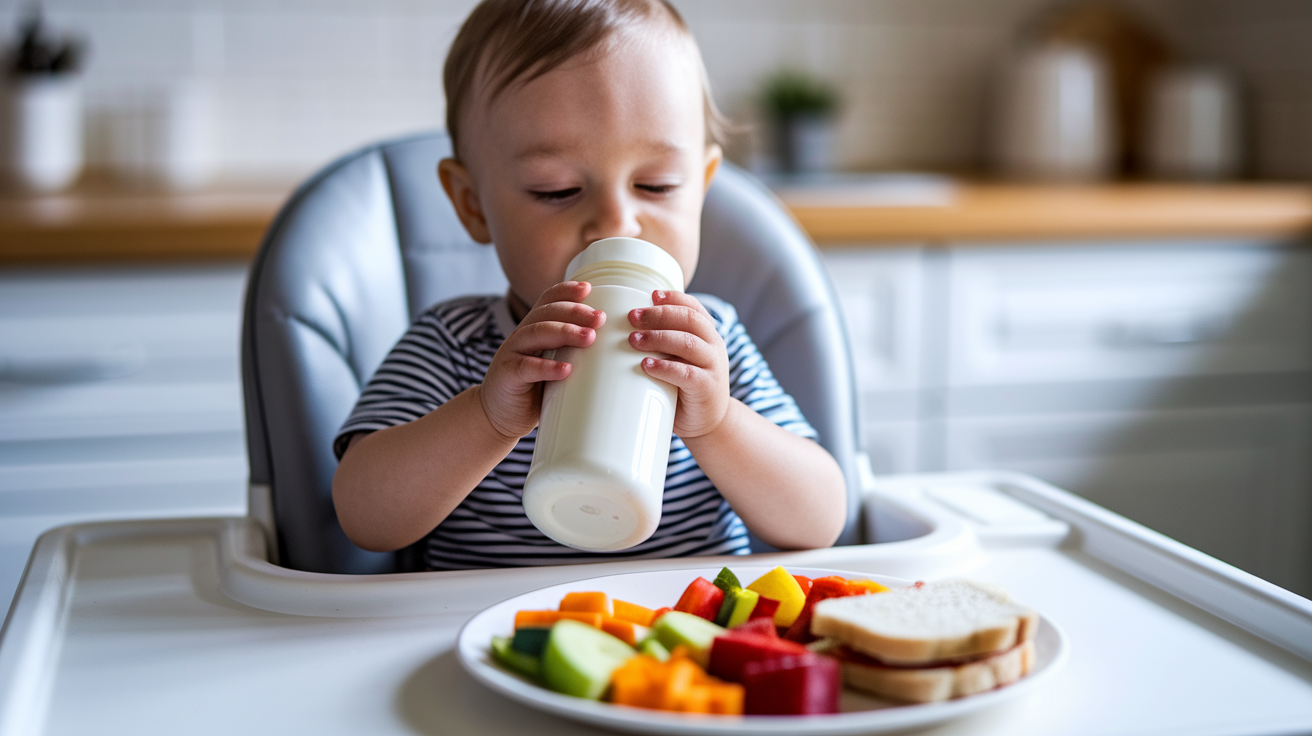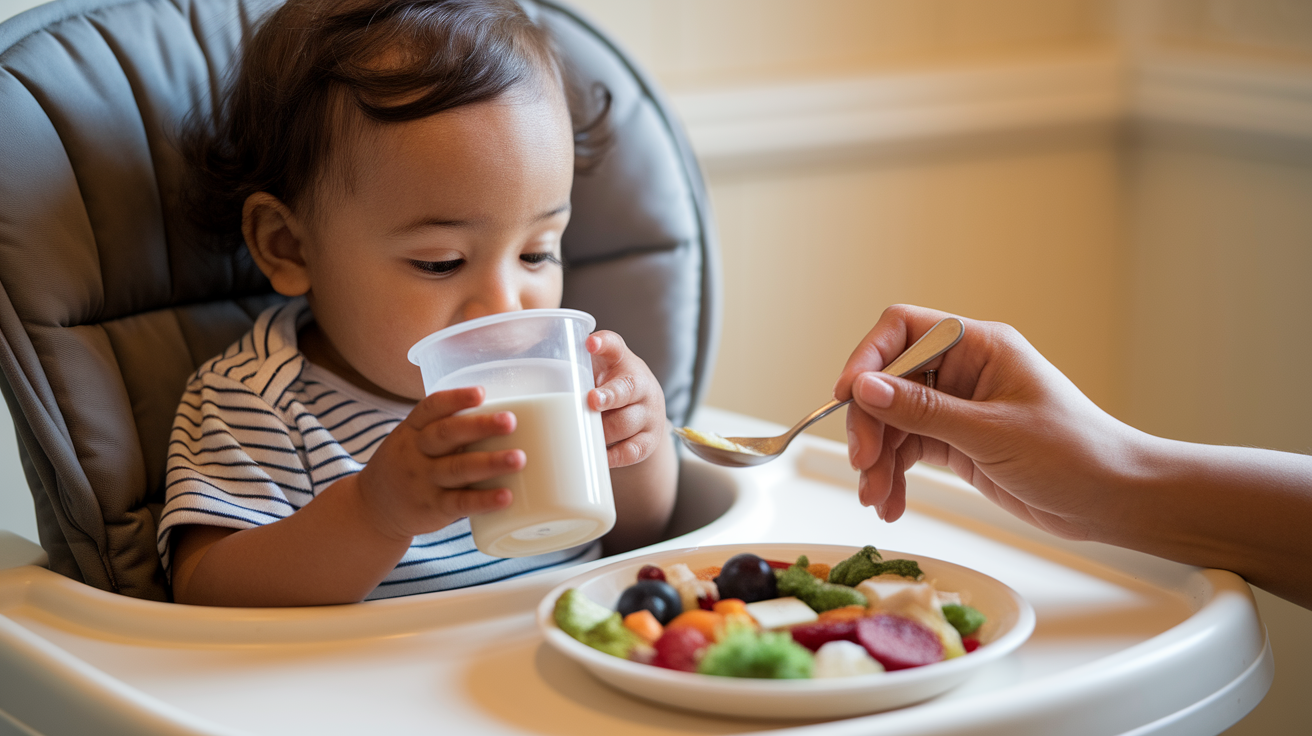My 2-Year-Old Refuses Food, Only Drinks Milk: Why?

The dinner plate sits untouched again. A parent watches their 2-year-old push away every spoonful of food, then reach for that familiar cup of milk with both hands.
Sound familiar? This scene plays out in countless homes every day. When toddlers refuse meals but gulp down milk like it’s going out of style, parents start to worry.
Is their child getting enough nutrition? Are they doing something wrong? The stress can feel overwhelming.
Here’s the thing – this behavior is more common than most parents realize. There are real reasons why some toddlers become “milk-only” kids, and there are gentle ways to help them branch out.
This guide breaks down what’s happening when little ones reject milk food, plus practical steps parents can take to encourage healthier eating habits without turning mealtimes into battles.
Is It Normal for a 2-Year-Old to Refuse Food in Favor of Milk?
It’s pretty standard for a 2-year-old to go through phases where they refuse food and show a strong preference for milk.
Toddlers are naturally picky eaters as they explore independence and test limits. While wanting milk is typical, consuming too much can reduce appetite for solid food and lead to a nutritional imbalance.
Generally, two to three small servings of milk per day are sufficient for this age group. If your child drinks a lot of milk but eats very little, try offering smaller milk portions after meals instead of before.
Most picky eating is temporary and resolves with patience and routine.
However, if refusal persists or growth appears to be affected, it’s wise to discuss this with a pediatrician for reassurance and guidance.
Possible Reasons Why Your Toddler Only Wants Milk

It’s normal to worry when your toddler only wants milk and skips other foods. Understanding possible reasons helps you respond calmly and know when to get help.
- Comfort and habit – Toddlers often find milk soothing and comforting, especially if it’s part of a bedtime or nap routine.
- Teething or mouth discomfort – Sore gums or mouth pain can make chewing difficult, so they prefer the ease of drinking milk.
- Illness or temporary low appetite: Colds, fevers, or mild stomach bugs can lower appetite for solids, but milk feels gentle and familiar.
- Sensory sensitivities or texture aversions: Some toddlers struggle with certain food textures and prefer the consistent feel of milk.
- Behavioral factors or power struggles – Refusing food and demanding milk can sometimes be a way to assert control or get attention.
If you feel something isn’t right, trust your instincts and check with your child’s doctor. Most phases pass, but support is always available.
Nutritional Risks of Excess Milk and Insufficient Solid Food
Milk is essential for toddlers, but consuming too much can lead to serious nutritional issues.
| Problem | What Happens |
|---|---|
| Iron Deficiency Anemia | Excessive milk interferes with iron absorption and reduces the intake of iron-rich foods. |
| Poor Weight Gain | Heavy milk reliance can limit appetite for calorie-dense solid foods |
| Missing Key Nutrients | Kids lose out on fiber, zinc, and healthy fats found in varied solid foods |
| Tooth Decay Risk | Constant milk sipping, especially from bottles, increases dental problems |
The sweet spot is 16-24 ounces of milk per day, while focusing on a diverse range of solid meals and snacks. This balance ensures toddlers get milk’s benefits without missing other crucial nutrients they need to thrive.
Signs You Should Talk to a Pediatrician or Feeding Specialist

Sometimes, picky eating is just a phase, but in other cases, it may signal a more serious issue. Knowing the red flags can help you decide when it’s time to seek expert guidance.
- Extreme pickiness that doesn’t improve – If your toddler consistently refuses entire food groups or eats fewer than 10 foods long-term.
- Weight loss or poor growth – A noticeable drop in weight or failure to follow the growth curve is a concern.
- Delayed oral motor skills, including difficulty with chewing, swallowing, or transitioning to textures beyond purees, may signal developmental delays.
- Tantrums around all foods – Intense distress, anxiety, or meltdowns during most meals can indicate deeper feeding challenges.
Don’t wait for things to worsen; early help from a pediatrician or feeding specialist can make a big difference.
What Can You Do at Home to Encourage Eating?
Supporting your toddler through a picky eating phase starts with small, consistent changes at home.
Begin by limiting milk to 16–24 ounces per day, leaving room for real hunger and solid foods. Offer small, frequent meals and snacks throughout the day rather than focusing on large portions.
Keep mealtimes calm, consistent, and free of distractions like screens, which can help your child focus on the food.
Introduce new textures and flavors slowly, without forcing them, and allow your child to learn at their own pace. Most importantly, use encouragement and praise rather than pressure or punishment.
Positive reinforcement, like clapping or smiling, encourages trying new things, boosts confidence, and makes eating more enjoyable for all.
Real Stories from Parents: “My 2-Year-Old Refuses Food, Only Drinks Milk”
You’re not alone; many parents have faced this tricky phase and found small wins along the way. Here are a few honest stories to remind you that progress is possible, one bite at a time.
1. Emma’s Story: The Bedtime Bottle Habit
Emma, mom to 2-year-old Noah, noticed he would skip dinner altogether and wait for his warm bedtime bottle. She gradually reduced the amount of milk in the bottle and offered a small snack before bedtime instead.
It took two weeks, but Noah gradually started eating more solids at dinner once the bedtime bottle was reduced. Emma says that patience and a firm, yet gentle, routine worked best for them.
2. Raj’s Story: Teething Troubles
Raj’s daughter, Aanya, suddenly refused all solids at age two during a tough molar teething phase. She only wanted cold milk to soothe her gums.
Raj’s pediatrician suggested cold, soft foods like yogurt and mashed bananas. By offering these along with her milk, Aanya stayed nourished and eventually returned to normal eating when her gums felt better.
3. Mia’s Story: Power Struggle at Mealtime
Mia struggled with her son, Leo, who drank milk constantly and threw tantrums at mealtimes. She realized mealtimes had become stressful battles. She switched off the TV, served tiny portions of fun finger foods, and praised him for even touching new foods.
She also set a clear “milk only after meals” rule. Over time, Leo’s tantrums faded, and he began tasting new bites with less drama.
Conclusion
Every parent watching their toddler push away perfectly good food while reaching for another cup of milk feels the same worry. It’s completely normal to question if they’re doing something wrong.
Here’s the truth: most kids go through this phase. Their little bodies are still learning to guide big emotions, new textures, and growing independence. The milk obsession usually fades as they develop.
Parents shouldn’t panic or turn mealtimes into battlegrounds. Instead, they can stay patient, keep offering variety, and trust that their child will eventually branch out.
Remember, this phase is temporary. With gentle consistency and patience, most toddlers find their way back to eating solid foods.
What’s your experience with picky eating phases? Please share your story in the comments below, and check out our other parenting blogs.






